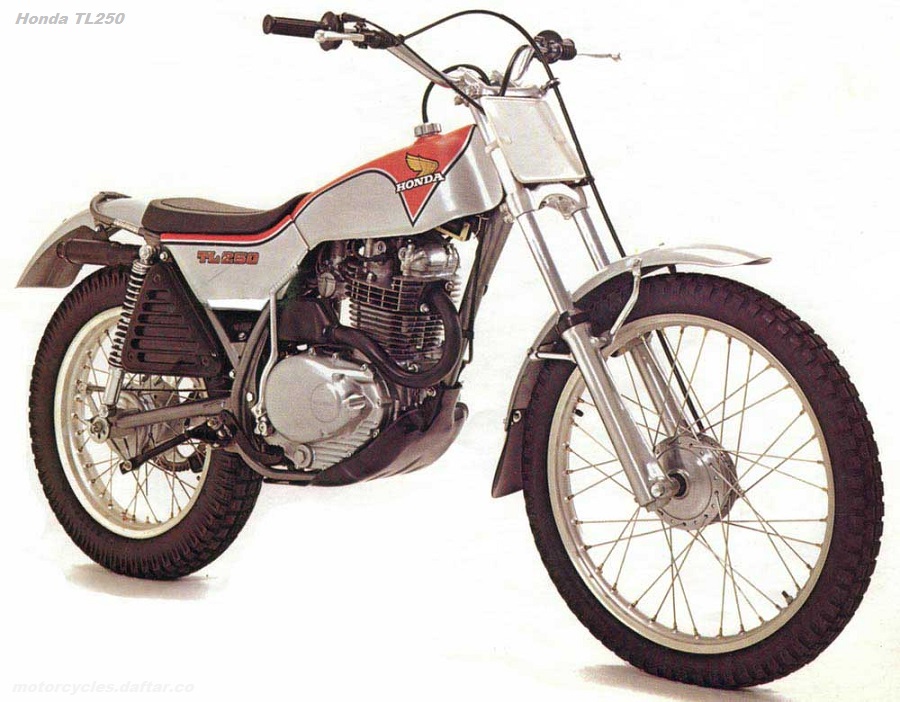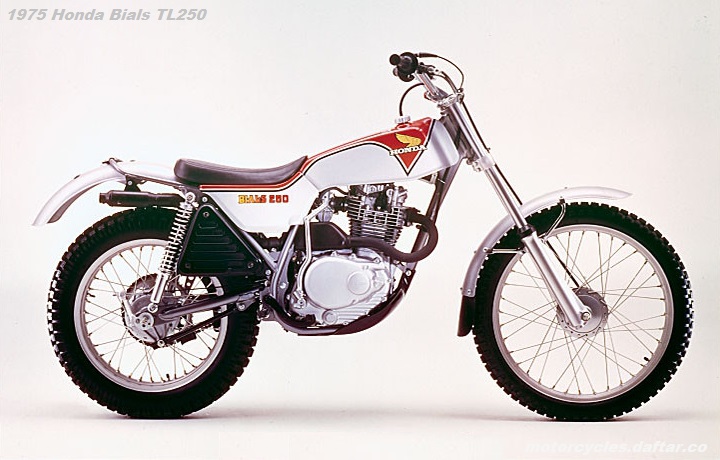1975 Honda Bials TL250 Original Specs & Photos Gallery
The 250cc Exclusive Trials Machine
 |
| 1975 Honda Bials TL250 photo. ホンダ バイアルス TL250 |
Honda Bials TL250 was a Trials exclusive model released in January 23, 1975 (Showa 50). As a model with the name Bials, which is a combination of “motorcycle” and “trials,” it follows the Bike Bros TL125 (1973). It was a competition-only car (MFJ Japan Motorcycle Sports Association, official recognition) without safety parts such as. An air-cooled 4-stroke single-cylinder OHC engine with a displacement of 248cc is mounted on a semi-double cradle frame. In consideration of driving through deep puddles, the intake port was set at a high position to improve water resistance and flooding. The transmission is a 5-speed return type, and the 1st to 3rd gears are close ratio low gears, gears for running the trial section, and the 4th and 5th gears are cruising gears for moving between sections. was done. As a competition-only model, it is also lightweight, with a magnesium alloy crankcase, an aluminum fuel tank, and polypropylene front and rear fenders. The vehicle weight was held down to 99kg, which is unusual for a 250cc model.
Following the popular Honda TL125, this motorbike is a powerful machine developed for advanced riders who want to enjoy Trials even more dynamically.
1975 HONDA TL250 Trial motorcycle built by master Sammy Miller based on SL250S for domestic market. Won 1st place in the American Championship in its debut year, and developed into the works RTL360.
 |
| Honda Bials TL250 picture. Release Date : January 23, 1975. Price in the year of 1975 was 295,000 yen (national standard cash price). MFJ Certified : February 4 (planned) |
1975 Honda Bials TL250 Main Features
Engine related
- Equipped with a reliable 4-cycle single-cylinder OHC 4-valve engine that delivers flexible power over a wide rev range.
- It generates a large amount of torque even at extremely low speeds, and combined with the effect of the exhaust pre-chamber, it has transient characteristics at low and medium speeds and flat torque characteristics with good response, making it easy to control even on slippery mud. , excellent traction (rear wheel grip) can be obtained.
- The 4-stroke engine makes it possible to adapt to a wide range of environmental changes, such as weather, and requires little maintenance.
- 4-cycle engine braking with good effect and low fuel consumption.
- The air cleaner is stored under the seat, and the intake port with a water shielding plate is installed at a high position. The sealing of the air cleaner case is tightened with rubber and bolts to further improve water resistance. The contact breaker is also equipped with a waterproof cover and blizzard pipe, and by raising the spark arrestor (certified by the US Forest Conservation Service) to a higher position, the water resistance is further improved, and it demonstrates its power when driving underwater. In addition, since the breather pipe is 2-way, it is easy to restart underwater.
- The carburetor has good characteristics such as low temperature starting, stability, and high temperature restartability, and provides a smooth response.
- The entire exhaust system is housed inside the frame. The double-walled muffler cuts high-frequency sounds, and while maintaining a powerful tone, it is a quiet and comfortable exhaust sound that is far below the ’75 CHP (California Highway Patrol) off-road standard (86db).
- The transmission has a 5-speed return shift, 1st, 2nd and 3rd gears are low cross, and 4th and 5th gears are wide ratio design that is effective for course movement.
Frames
- The frame is a lightweight and highly rigid semi-double cradle type ideal for trialers.
- Brakes use FMVSS122-cleared linings and have excellent performance in fine weather and rain, as well as water resistance recovery. Moreover, both the front and rear wheels have wear limit check scales for the brake shoes.
- The front fork minimizes the offset to the center of the steering, and adopts a front geometry that cleverly combines the axle offset and slanted angle. There is little change in the trail, and the inertial weight around the steering is reduced.
- The rear wheel sprocket uses 57 teeth made of high-tensile aluminum alloy. Unsprung weight is also reduced.
- The rims are made of aluminum, which is light and does not clog easily.
- In addition, the magnesium alloy crankcase cover, light and durable duralumin arch-shaped fork bridge, aluminum fuel tank, polypropylene front and rear fenders, etc. resulted in a weight reduction of 100kg, which is unusual for a 4-stroke 250cc vehicle. We have achieved the following:
- The cushion stroke is 180mm for the front wheels and 105mm for the rear wheels at an ideal diagonal angle, so it has good follow-up performance and brings good results on extremely rough roads. Moreover, the firmness of the rear wheel cushion can be adjusted in 5 stages.
- Split type handle lever bracket that can be replaced without removing the grip rubber.
- Since the side stand is attached to the rear fork, it moves with the vertical movement of the rear wheel, so the ground clearance of the stand is always constant.
- The steering angle is generously set at 62 degrees on both the left and right sides so that it can be used in difficult sections.
1975 Honda Bials TL250 Specifications
| Total length (m) | 2.050 | |
| Width (m) | 0.840 | |
| Total height (m) | 1.110 | |
| Length (m) | 1.325 | |
| Seat height (m) | 0.770 | |
| Minimum ground clearance (m) | 0.260 | |
| Vehicle weight (Kg) | Front axle | 45 |
| Rear axle | 54 | |
| Total | 99 | |
| Engine | Air-cooled 4-stroke OHC | |
| Number and arrangement of cylinders | Upright single cylinder | |
| Inner Diameter x Stroke (mm) | 74.0×57.8 | |
| Total Displacement (cc) | 248 | |
| Compression Ratio | 9.1:1 | |
| Max output (PS/rpm) | 16.5/7,000 | |
| Max torque (Kg-m/rpm) | 2.0/5,500 | |
| Weight (Kg) | 36.5 | |
| Carburetor | PW24 | |
| Lubricant capacity (L) | 1.8 | |
| Clutch type | Wet multi-plate | |
| Transmission method | Left foot return 5 steps | |
| Transmission ratio | I | 3.000 |
| II | 2.294 | |
| III | 1.591 | |
| IV | 1.036 | |
| V | 0.750 | |
| Primary reduction ratio | 3.261 | |
| Final gear ratio | 4.071 | |
| Transmission method | Chain | |
| Ignition method | Flywheel magneto | |
| Starting method | Brimary kick | |
| Frame format | Semi-double cradle | |
| Minimum turning radius (m) | 1.6 | |
| Front wheel suspension | Telescopic | |
| Rear wheel suspension | Swing arm | |
| Drive system | Chain | |
| Brake type (front) | Drum | |
| Brake type (rear) | Drum | |
| Tire size (front) | 2.75-21-4PR | |
| Tire size (rear) | 4.00-18-4PR | |
| Fuel tank capacity (L) | 3.8 | |
| Cushion stroke (before) | 180 | |
| Cushion stroke (after) | 105 | |
| Caster/Trail | 63°30′/86mm | |
| Steering angle | Both left and right 62° | |
| Footrest width (m) | 0.440 | |